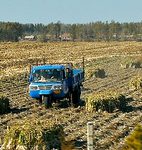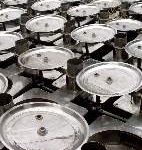[Produced in association with Rutgers Climate and Social Policy Initiative]
Recent years have seen coal-mining efforts shift from China’s northern Shanxi province to the grasslands of places like Inner Mongolia. But when Inner Mongolia is providing such easily exploitable sources of energy and chemical products, will it not just become another Shanxi? The environment in Inner Mongolia is even more vulnerable. Although technology can be used to repair a certain amount of damage, it would take a significant amount of time and money. We must remember that no amount of money can replace the soil carried off by sandstorms.
Will energy companies be willing to invest huge sums to repair the ecosystems they have damaged? Will the nation have to accept higher energy prices for the sake of the grasslands? With the energy firms faced with the temptation of huge profits, it is hard to be optimistic about the fate of the grasslands.
When huge quantities of fossil fuels are extracted, the carbon stored within them for hundreds of millions of years will be released into the atmosphere. This situation makes the already difficult task of reducing overall carbon emissions even harder. But sooner or later the problem will have to be addressed. If we want to break out of the vicious circle of using fossil-fuel energy, we must shift our reliance to clean energy sources such as bioenergy, solar power and wind power.
In this transformation process, rural energy will be developed, the environment improved and greenhouse gas emissions reduced. If we continue with our current strategy of dependence on fossil fuels, we will ignore the potential contributions of 800 million rural residents. Even if those rural residents do become rich, they will battle for energy with the cities and industry – and we will never be able to mine enough coal.
China’s population is mainly rural, and if that population realises its full potential for consumption, we will have no way to control the continually increasing greenhouse-gas emissions. Many wealthy farmers already are using energy-hungry appliances such as air-conditioners, refrigerators and microwave ovens, as well as coal for heating and cooking. Yet, they ignore the traditional bioenergy sources at their doorsteps — like straw – by simply burning them off in the fields.
So what if the millions of villages in China were mobilised? For answers, let us look at the experimental data collected by the Institute of Botany at the Chinese Academy of Sciences and Shandong Agricultural University.
The experiment entitled “Using straw as livestock fodder to promote circular energy use in rural areas” was carried out in the village of Jiangjia in Shandong province. The village is home to 923 people, and has 68 hectares of land – an average of 1.097 mu (.073 hectares) per person. Farming is the main industry in a typical village. Our experiment is aimed at making full use of the straw that farmers discard.
This straw fodder can be feed to cows, thus turning straw into dung. The dung could then be converted into methane gas for energy and organic fertiliser, which could replace 50% of chemical fertiliser use. Energy for heating and cooking would come entirely from methane gas, replacing coal, natural gas and electric ovens. This improvement would make the villagers self-sufficient in energy, with a small surplus that could be sold to urban areas.
In 2005 and 2006, the village had only two or three cows. Since our study started in 2007, the village has raised and sold 50 head of cattle. The village currently has 99 cows in the cattle pens, and by 2009 may have raised a total of 200. With the help of the experts, the village has increased its stock of cattle fifty-fold. These animals have been fed almost entirely on previously discarded straw, with only 10% of their fodder coming from purchased grain.
Utilising dung as an energy source has allowed the researchers to persuade the county agricultural authorities to install methane generators in 100 households, with 93 installations already complete. In addition, 30 households installed the equipment at their own expense. This brings the total installations to 123 households, which signifies that over half of the entire village are now producing methane.
Every household produces an average of 1.3 cubic meters of methane per day. Using methane for cooking saves 339 kilogrammes of coal annually, reducing carbon dioxide (CO2) emissions by a little over one tonne. The entire village saves 41.6 tonnes of coal, reducing emissions by 133 tonnes. International carbon prices put the cost of one tonne of CO2 emissions at US$200. Using these calculations, this project has earned 244,000 yuan (US$35,882).
China has 3.2 million villages. If similar methane projects were undertaken in each one, 853 million tonnes of CO2 emissions would be avoided every year (current annual emissions are seven billion tonnes annually). If one takes into consideration the 50% reduction in use of chemical fertiliser and the carbon returned to the fields via organic fertiliser, and the emission reductions are even larger.
During the summer, more methane was produced than could be used. If this gas was collected and compressed, it could be used in place of liquefied natural gas to supply the village’s energy needs during the winter. Unfortunately, there currently is no investigation of the potential for reduced carbon emissions in Chinese rural areas, and carbon trading in these locations is non-existent. This study shows that there is a huge potential for energy-generation in rural areas, and this prospect should be given full attention.
Moreover, the farmers made significant profits from the energy substitution. It costs 6,152.50 yuan (US$904) to raise a cow, which is then sold for 7,924.50 yuan (US$1,165) leaving a profit of 1,772 yuan (US$261). This represents a 50% annual return on investment, and net profit of between 2,500 yuan (US$367) and 3,000 yuan (US$441) per cow over eight months. If our proposal of “three cows per household” were implemented in straw-rich areas, the farmers would no longer need to migrate into cities to work. The farmer’s income while working at home would then be over 10,000 yuan (US$1,470).
Solving the energy crisis will require a multi-pronged approach. Reducing the country’s dependence on fossil fuels must include our rural residents. Chinese policies should encourage them to use the energy sources naturally available rather than force rural locations to compete with cities and industry for fossil fuels. If China pays some attention to rural energy and makes full use of biological converters such as cows, sheep and methanogenic bacteria, 700 million tonnes of straw can be converted to energy and high-quality fertiliser.
In this scenario, food production will no longer turn fields white with agricultural membrane, but dark with rich fertiliser. The government will not only be closer to its goals of reinvigorating its villages, but China also will save energy, reduce emissions and increase food production.
Jiang Gaoming is a professor at the Chinese Academy of Sciences’ Institute of Botany. He is also vice secretary-general of the China Society of Biological Conservation and a board member of the China Environmental Culture Promotion Association. Jiang is known for his concepts of “urban vegetation” and allowing damaged ecosystems to recover naturally.
Produced in association with:
Homepage photo by .micki.



